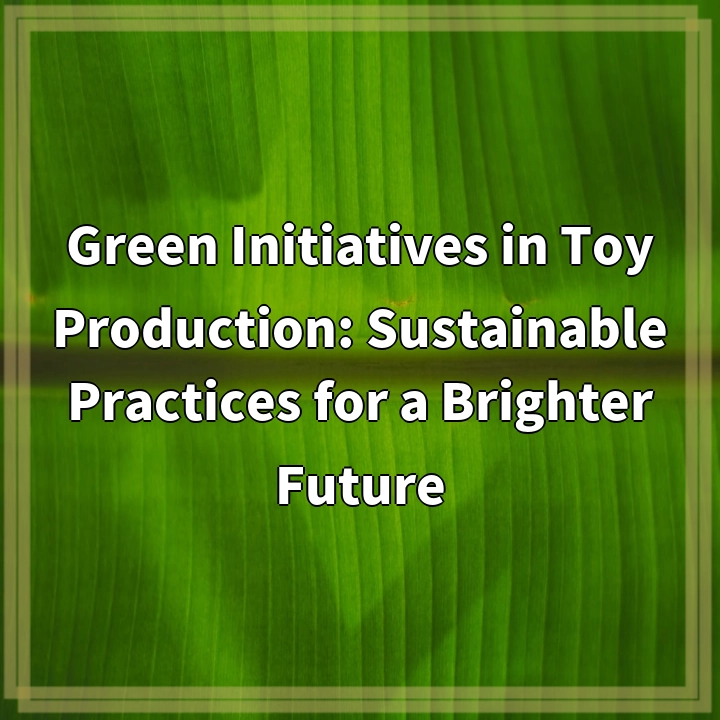
What it is:
The toy industry is undergoing a significant transformation as manufacturers increasingly adopt green initiatives in response to growing environmental concerns. Green initiatives in toy production focus on utilizing sustainable materials, reducing carbon footprints, and implementing ethical manufacturing practices. These initiatives aim to create toys that are safe for children and the environment while promoting a circular economy. From biodegradable plastics to recycled materials and eco-friendly packaging, businesses are exploring innovative ways to make the toy production process more sustainable. As awareness of environmental issues grows, the demand for green toys is rising, encouraging manufacturers to rethink their production methods and prioritize sustainable alternatives.
Real-world problems:
Despite the positive shift toward green initiatives in toy production, several real-world problems persist. One significant challenge is the reliance on traditional materials and processes that are not environmentally friendly. Many toys are still made from petroleum-based plastics, which contribute to pollution and are difficult to recycle. The manufacturing process itself can also generate significant waste and greenhouse gas emissions, undermining the very goals of sustainability.
Another issue is the lack of standardization in what qualifies as “green.” Various certifications exist, but the criteria can vary widely, leading to consumer confusion and greenwashing, where companies market their products as environmentally friendly without meaningful action to back it up. This can make it difficult for parents and consumers to trust claims about a toy’s sustainability.
Furthermore, the cost of producing sustainable toys can be higher than their traditional counterparts. This may discourage some manufacturers from adopting green practices, especially smaller businesses with limited resources. The higher price point can also be a barrier for consumers, who may be reluctant to spend more on eco-friendly toys.
Lastly, there is a challenge in raising awareness and educating consumers about the importance of choosing sustainable toys. Many parents are still unaware of the environmental impact of conventional toy production and the available sustainable alternatives. As educational initiatives lag, the demand for green products may grow slowly, hindering progress in the industry.

Solutions to Green Initiatives in Toy Production
To address the challenges in adopting green initiatives in toy production, several solutions can be implemented by manufacturers, consumers, and industry stakeholders. These solutions can significantly contribute to promoting sustainable practices and enhancing the overall impact on the environment.
1. Embrace Sustainable Materials
Manufacturers can prioritize the use of sustainable materials such as biodegradable plastics, wood from responsibly managed forests, and recycled materials. By sourcing eco-friendly materials, companies can significantly reduce the environmental impact of their products while providing safer options for children.
2. Implement Eco-Efficient Manufacturing Processes
Investing in energy-efficient technologies and optimizing production processes can help minimize waste and lower greenhouse gas emissions. By adopting lean manufacturing principles, toy companies can streamline their operations to be more environmentally friendly and cost-effective.
3. Standardize Green Certifications
Establishing clear and consistent standards for green certifications can help eliminate confusion among consumers. Industry stakeholders and regulatory bodies can work together to create trustworthy guidelines that ensure toys labeled as eco-friendly truly meet sustainability criteria, thereby enhancing consumer confidence.
4. Promote Affordability through Innovation
Encouraging innovation in sustainable product design can lead to cost reductions in the long run. As demand for green toys increases, scaling production can help lower prices, making sustainable options more accessible to a broader range of consumers.
5. Educate Consumers
Raising awareness about the importance of sustainable toys is vital for driving change. Brands and organizations can implement educational campaigns to inform parents about the environmental impact of their toy choices, highlighting the benefits of eco-friendly alternatives and how they contribute to a healthier planet.
6. Collaborate and Share Best Practices
Collaboration among manufacturers, researchers, and NGOs can foster the exchange of knowledge and innovative ideas. By working together, stakeholders can develop best practices and create a supportive community that prioritizes sustainability in the toy industry.















